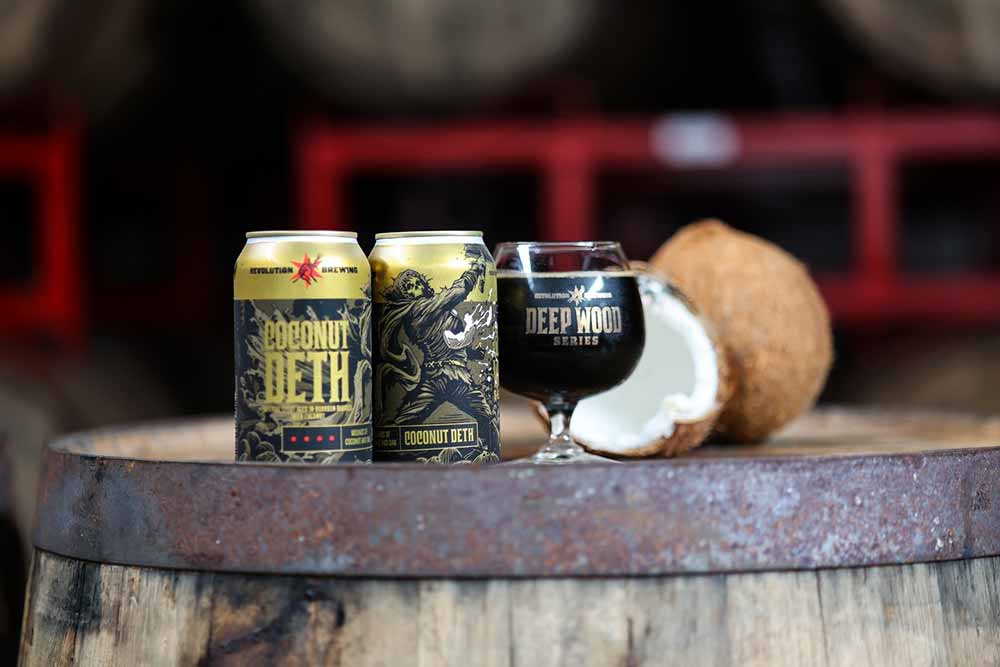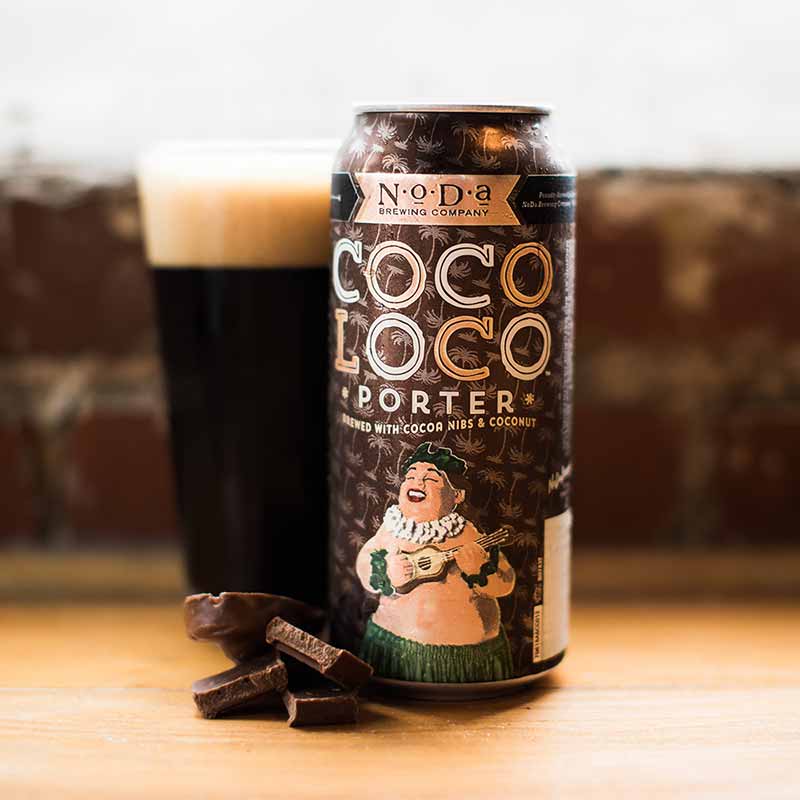
We’ve provided several top guides featuring brewers’ insights on crafting beers with adjuncts, including honey, fruit purees, and chocolate. Another popular ingredient, coconut, whether used with nuance or aggressively, brings an intense aroma that can elevate a finished beer.
However, using coconut comes with its own set of unique challenges. We chatted with brewers from Maui Brewing and NoDa Brewing to learn the goal of using coconut in beer, how much to use, and when to add it for the best results.
(Above photography courtesy of Revolution Brewing)
What We’ll Cover in This Piece:
Affordable, Industry-Leading Brewery Software
What the Experts Hope to Achieve by Adding Coconut to Beer

Photography courtesy of NoDa Brewing Company
Maui Head Brewer James Newman says the primary benefit of brewing with coconut comes from the oils, which catalyze its distinct aroma. But it needs a delicate touch.
“We strive to maintain a balance,” Newman says. “Because too much oil can have a negative impact on the beer’s head retention.”
NoDa Head Brewer Chad Henderson says the company has been brewing with coconuts since its start. Coco Loco, the second beer they brewed—now more of a seasonal—adds coconut to a robust porter recipe.
“It’s a neat adjunct to play with,” Henderson says, noting Coco Loco won a 2012 Great American Beer Festival silver and a 2021 U.S. Open Beer Championship bronze.
He says NoDa has changed its methodology for using coconut over the years, but the goal remains the same.
“We want coconut to add sweet complexity, something like a cookie flavor,” Henderson says. “We don’t want to make it aggressively coconut. We’ve done that before for the big tropical punch-in-the-face coconut, but the majority has been for nuance to the malt flavor.”
What Is the Best Type of Coconut to Use in the Brewing Process?

Photography courtesy of Maui Brewing Co.
“Toasted,” Newman says. “Hands down.”
Newman says the toasted coconut brings out the best qualities of the fruit.
“There’s nothing like the smell of freshly toasted coconut—it is by far the best form,” he says. “Our goal is to capture that essence in a glass.”
But the toast has to be precise.
“The degree of toasting greatly influences the flavor profile achieved,” Newman says. “We aim to toast the coconut until it reaches a point where it just begins to turn golden while ensuring there are still areas of white flesh evenly scattered throughout.”
He adds, “This stage begins to release the oils, making them accessible without the risk of burning off.”
Henderson says they’ve tried using coconut in a multitude of ways but found the most effective one.
“We get shaved coconut and then lightly toast it,” says Henderson, who adds they run it through a hopback. “We’ll toast that depending on what we want to get out of it.”
Henderson says that there are a number of other forms of coconut you can use in your beer, whether it be raw, shaved, shredded, fine, or even flavorings. But no matter the choice you go with, there is one thing that is necessary.
“I would definitely lean towards using Unsweetened coconut regardless [of the type you get],” Henderson says. As to what type, he says, “It just depends on what your setup is and what flavor profile you want to dial in on.”
He adds, “Flavorings … definitely have their own assertive taste to them, which isn’t to say it’s not an option; it’s just preference.”
Henderson notes that if you use fine coconut, it gets everywhere and creates a problem.
“The thicker-sliced shreds hold better, so you don’t have to worry about them clogging up the heat exchanger,” he says.
When Do You Add Coconut in the Brewing Process?

Photography courtesy of Maui Brewing Co.
Henderson explained that they used to add coconut into the whirlpool with mixed results.
“We evolved that to no coconut on the hot side and made big de-aerated tea, taking toasted coconut in bags, steeping it, and then knocking it out to the fermenter or brite,” he says. “That worked better, but it messed with the gravity, and we could get inconsistent appearance because of the fat content.”
NoDa considered adding it to the fermenter on the cold side, but their port sizes didn’t allow for it. Eight years later, as the company grew to a sixty-barrel brewhouse, Henderson says they took all that into account.
“We designed a hopback specifically for the coconut beer,” he says.
Newman says they add the toasted coconut to the finished beer after centrifuging or filtering.
“We find that we get the cleanest extraction that way, and it provides the most impact,” Newman says. “Generally, the later you add an ingredient in the brewing process, the greater its influence on the final product.”
How Much Coconut Should You Use?

Photography courtesy of @tgbrews
Henderson says they’ve messed around a bit with coconut ratios—both on the low and high ends—and trialed their way to a good amount.
“We do just short of a pound per barrel,” Henderson says. “Around fifty pounds per sixty-barrel batch.”
When they moved from a fifteen-barrel operation to a sixty-barrel operation, Henderson says they scaled up the coconut accordingly.
“We tried twenty-five pounds in a sixty-barrel batch … but it didn’t do enough,” Henderson explains. “We tried to do seventy-five pounds at one point, but you could see the fat chunks showing. We were happy with fifty pounds and have stayed with that since.”
He adds, “It’s also good when units are exact measurements. It makes it more precise.”
Newman says that the amount of coconut used depends on several factors.
“Typically, with this ingredient, the more, the better,” he says. “But some styles benefit from a lighter touch.”
Newman adds that you must also factor in the cost of goods and brewing frequency.
“If you’re using a large quantity of coconut in a beer you produce frequently, like a core beer, it could get expensive and labor intensive,” he says. “After years of experimentation, we’ve found that using anywhere from three to eleven pounds per barrel works for us.”
Maui uses considerably more coconut than NoDa. While Henderson says he prefers to undershoot and add as needed, Newman says, “It’s harder to overdo coconut, in my opinion. But … too much could destroy your head retention,” he says. “Undershooting could rob the beer of its potential and would waste the ingredient.”
Henderson says that coconut is relatively inexpensive—around $5 to $10 per pound, depending on processing—and can be procured in bulk from a number of providers. That cost doesn’t factor in added labor costs for cleaning, which varies based on the method you use.
“There’s labor in cleaning if you’re trying to do a steep or make a tea as there is a fair amount of oil product left behind,” he says. “But if you have a hopback or a setup that will allow continuous pass over, it’s not that different than cleaning after the use of any normal ingredient such as hops.”
Newman adds one tip to look out for when brewing with coconut.
“It’s important to watch out for potential microbiological contamination and the risk of dissolved oxygen pickup,” he says. “These considerations should be standard practice throughout the brewing process, but if you’re using fresh, hand-toasted coconut in finished beer, the risk is slightly higher.”
If something goes awry, Henderson says, at that point, you “gotta make the call on what to do and whether you gotta cut your losses.” He adds that sometimes blending could work, but he discovered an excellent insurance policy if something goes wrong.
“We’ve found that vanilla can nicely complement coconut and serve as a good backup plan,” Newman says. But use it sparingly because it’s easy to overpower with vanilla.”
Which Beer Style Best Showcases Coconut?
Think of something dark. Newman says traditionally, coconut works best in porters, stouts, and their imperial versions. But resting on laurels isn’t something Maui wants, so Newman says they’ve dabbled in new trials with coconut.
“Lately, we’ve been experimenting with beers inspired by Southeast Asian desserts, incorporating fruit and coconut, and it has been surprisingly rewarding,” says Newman, noting Maui’s Mango Stickee Rice IPA. “While hops, fruit, and coconut may not seem like an obvious combination, I dare say this is one of the best beers I’ve ever tasted.”
Henderson, too, says porters, stouts, and pastry stouts are great when using coconut but also sees coconut as a versatile ingredient.
“Our market buys more porters, so that’s why we do that,” Henderson says. “But I love doing lighter beers like blondes—it’s a nice contrast.”
Two Great Examples of Coconut in Beer

Photography courtesy of Maui Brewing Co.
Maui has its Coconut Hiwa Porter (CHP), their “OG coconut beer” released nearly twenty years ago. CHP, 6% ABV with thirty IBUs, is a robust dark ale with hand-toasted coconut and hints of mocha, according to the Untappd page.
“CHP was the pioneer of commercial coconut beers, establishing Maui Brewing’s presence in the industry,” Newman says. “It paved the way for the multitude of coconut beers you now find on the market.”
NoDa’s Coco Loco is a 6.2% ABV robust porter with forty IBUs. Made with a blend of chocolate and brown malts, it has a subtle bitterness of chocolate balanced by organic toasted coconut, the Untappd page describes.
“It’s a nice example of having a soft hand at coconut,” Henderson says. “And the flavors all meld together.”



